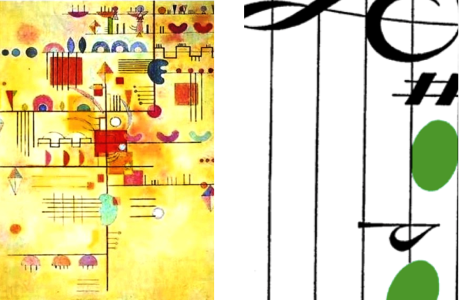Impossible Art
My dissertation looks at cross-modal Modern art and literature through the lens of neuroscientific studies in clinical synesthesia. I argue Modernist artists and writers thought of their works as scientific experiments as much as experiments with form or style.
More specifically, Modernist artists and writers experiment with cross-modality in different ways than their predecessors. Writers from Shakespeare to the Baudelaire play with cross-modal metaphors in their compositions, however, many Modernists, I argue, attempt to actually create cross-modal experiences for their audience. The Modernists I discuss endeavor to generate a sensation in one sensory modality (say, smell) while providing a sensory stimulus in a different sensory modality (say, vision). The term I use to designate this type of composition is impossible art.
Modernism is replete with examples of impossible art.
So much so, I argue that we deeply misunderstand the period. It is clear to me that these artists and writers conceived of themselves as investigators who thought reality might work differently than commonly believed. Their works of impossible art were, indeed, experiments in form, but they were not merely for art’s sake, but rather for the sake of exploring new ways that human beings might probe the nature of what is possible for human perception.
The Journey of Impossible Art
Contextual Support for a Reinterpretation of Modernism.
Long before the instability caused by the wars, various scientific discoveries just prior to and during the Modernist period cause a wide spread sense of uncertainty and unpredictability with respect to the world around us.
The first decades of the twentieth century undergo an upheaval with respect to perception. The late nineteenth century discovery of non-Euclidean geometry, which deals with the geometric rules of curved space, challenges theories as basic as a straight line is the shortest distance between two points.
In 1897, the electron is discovered; in 1911, the atom’s nucleus. We underestimate the revolutionary effect this had on those living at the time. Since ancient Greece, the atom had been conceived as smallest unit of matter; it was a basic and foundational aspect of existence that everyone understood. In his writings, Wassily Kandinsky remarks on the deep uneasiness he felt at the discovery of the electron; he cites this as motivation for his most experimental artworks. The discovery of the electron would eventually lead to the discovery of the proton and neutron. In 1905, Albert Einstein’s Special Theory of Relativity further changes how space and time are conceived.

Finally, the discovery of quantum physics in the 1920’s, jolts the scientific community with two major findings. First, quantum physics indicates that subatomic particles are not governed by the same laws of physics as larger objects. This means that some components of reality are not subject to the laws of classical physics that Isaac Newton discovered in the seventeenth century. Second, one of the laws that the new physics posits involves the relationship between an observer and the object of observation. Subatomic particles can exist in superposition—in more than one place at one time—until they are observed. The act of observation permanently alters the state of subatomic particles. These advances in the sciences demonstrate that the most obvious observations about reality are not necessarily accurate or complete. This, I argue, fuels the twentieth century’s rejection of naturalism and realism in art and literature.
The Modernists I discuss use these scientific events as a warrant for experimenting with the boundaries of the known world of perception. Some like Wassily Kandinsky and Umberto Boccioni write about the influence of these events on their artistic practice in their correspondences and journals. Others, like Edward Maryon use scientific data as justification for their cross-modal theories. And many others still, engage in pursing scientific theories of color, sound, vibration, or frequency on a general hunch that reality is not as straightforward as it may seem.